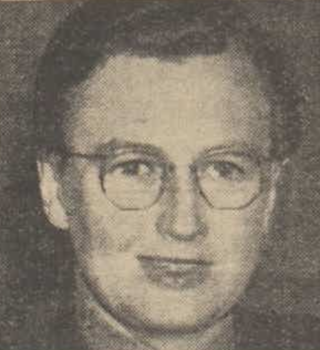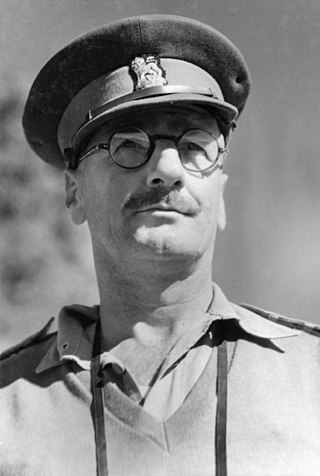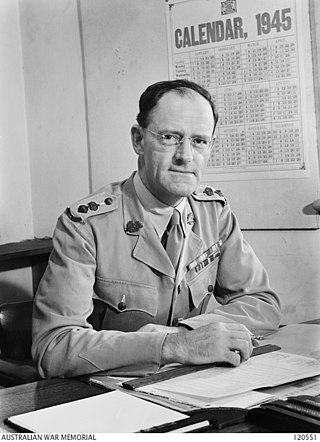Related Research Articles

The First Australian Army was a field army of the Australian Army, during World War II. The formation's headquarters was raised in April 1942 from the existing 1st Australian Corps headquarters, assuming command of all Allied troops in Queensland. Initially, the formation was assigned a defensive role in anticipation of a possible Japanese invasion; however, this threat subsided and eventually the army was deployed to Lae, in New Guinea, in late 1944, where it co-ordinated Australian offensives around Aitape, in New Guinea, on New Britain and Bougainville, and around Madang. The formation was disbanded in February 1946, when it was redesignated as the 8th Military District.

Colonel Matron Kathleen Annie Louise Best, was the first director of the Women's Royal Australian Army Corps.
Royal Australian Naval Volunteer Reserve (RANVR) was a reserve force of the Royal Australian Navy.

I Corps was an Australian Army corps, one of three that were raised by the Army during World War II. It was the main Australian operational corps for much of the war. Various Australian and other Allied divisions came under its control at different times. In 1940–1942, the corps was based in the Mediterranean and Middle Eastern theatres, and controlled forces in action against the Germans, Italians and later the Vichy French in North Africa, Greece and Syria–Lebanon.

Major General Sir Robert Joseph Henry Risson, was an Australian engineer, soldier, and tramway administrator. After university he worked for the Brisbane Tramways Trust, later under the auspice of Brisbane City Council, as an engineer and administrator. During World War II Risson served in the Middle East and New Guinea. Following the war he returned to the Brisbane tramways, and became chairman of the Melbourne and Metropolitan Tramways Board from 1949 to 1970. In this position he defended trams, and is considered a major factor in the survival of Melbourne's tram system. Risson had ties with a myriad of professional and community organisations, including the Freemasons, where he served as Grand Master of the United Grand Lodge of Victoria in the mid-1970s. Risson was decorated for his service, holding the rank of major general and being knighted.

Bundaberg Airport is a regional airport serving Bundaberg, a city in the Australian state of Queensland. It is located 2.5 nautical miles southwest of the city centre, on North Childers Road and Takalvan Street. The airport is owned and operated by the Bundaberg Regional Council. It is also known as Bundaberg Regional Airport.

Sir Thomas Walter White, was an Australian politician and pilot in the First World War. In 1914 he became one of the first airmen trained for the Australian Flying Corps (AFC), and the following year he was among the first AFC members to see action when he was deployed to the Middle East with the Mesopotamian Half Flight. After carrying out several missions behind Turkish lines, he was captured in November 1915 but escaped in July 1918. White was awarded the Distinguished Flying Cross and twice mentioned in despatches for his war service. He married Vera Deakin, a Red Cross worker and daughter of former Australian prime minister Alfred Deakin, in 1920.

Although most Australian civilians lived far from the front line, the Australian home front during World War II played a significant role in the Allied victory and led to permanent changes to Australian society.

The Rats of Tobruk is a 1944 Australian film directed by Charles Chauvel. An abridged version was released in the United States in 1951 as The Fighting Rats of Tobruk. The film follows three drover friends who enlist in the Australian Army together during World War II. Their story is based on the siege of the Libyan city of Tobruk in North Africa by Rommel's Afrika Korps. The partly Australian defenders held the city for 250 days before being relieved by British forces.
Red Sky at Morning is a 1944 Australian melodrama set during the 19th century based on a play by Dymphna Cusack. It features an early screen performance by Peter Finch, who plays a convict who falls in love with the wife of a sea captain.
A Yank in Australia is a 1942 Australian comedy film directed by Alfred J. Goulding and starring Al Thomas and Hartney Arthur.
Henry Stephen Bailey was an Australian politician. He was a member of the Victorian Legislative Assembly from 1914 to 1932 and from 1935 to 1950, representing the electorates of Port Fairy (1914–27) and Warrnambool. Initially an Australian Labor Party member, he served as Minister for Lands and Water Supply in the Prendergast and Hogan governments of 1924, 1927–28 and 1929–32, but was expelled from the party in 1932 during the 1931-32 Labor split and defeated at that year's election. He joined the Country Party in 1934 and won his old seat back for his new party in 1935, subsequently serving as Minister Without Portfolio (1935–36), Minister of Labour (1936), Chief Secretary (1936-43) and Attorney-General (1938–43) in the Dunstan government.

Major General Edward James Milford was an Australian Army officer who fought in the First and the Second World Wars.

Major General Victor Paul Hildebrandt Stantke, was a senior officer in the Australian Army, serving during the First World War and Second World War. His appointments were mainly to staff and administrative postings, including holding the position of Adjutant-General from 1940 to 1943, and commander Queensland Lines of Communication Area from 1943 to 1946.
Italian prisoners of war in Australia were Italian soldiers captured by the British and Allied Forces in World War II and taken to Australia.

Eustace Graham Keogh was an Australian Army officer and military historian who served in First and Second World Wars. He won the AMF Gold Medal Essay three times, and was the editor of the Australian Army Journal from 1948 to 1964. He published several books on the Australian Army's campaigns.

Harold Clive Disher, was an Australian Army officer who served in the First and Second World Wars, a medical practitioner, a champion rower, and a pastoralist. He stroked the first AIF eight which won the championship race at the 1919 Henley Royal Peace Regatta, and received the 1919 Helms Award for the most outstanding amateur athlete from Australasia. During the Second World War, he was in charge of medical services during the Battle of Bardia and the Battle of Buna-Gona.
Brigadier Eric Lacy Vowles, was an Australian soldier who served during the First World War and Second World War.
Viola Wilson was a Scottish singer, the leading soprano for J. C. Williamson's Gilbert and Sullivan company in Australia during World War II. She married the widowed theatre businessman Frank S. Tait, later Sir Frank.
Whose War Is It? is a 1943 Australian propaganda film from the Department of Information. It was released theatrically.
References
- ↑ "Allied Works Council | The Dictionary of Sydney". dictionaryofsydney.org. Retrieved 17 June 2024.
- ↑ "Full War Powers To Be Used". The News . Adelaide: National Library of Australia. 17 February 1942. p. 1. Retrieved 28 December 2014.
- ↑ "Allied Works Council in Australia during WW2". www.ozatwar.com. Retrieved 17 June 2024.
- ↑ Allied Works Council (Australia); Australia. Department of the Interior (1943), Report on the activities of the Allied Works Council for the period February 26, 1942 to June 30, 1943, Published by authority of the Minister for the Interior, retrieved 17 June 2024– via National Library of Australia
- ↑ "Civil Aliens Corps under AWC". The Argus (Melbourne) . No. 30, 167. Victoria, Australia. 4 May 1943. p. 2. Retrieved 17 June 2024– via National Library of Australia.
- ↑ "Civil Aliens Corps". The West Australian . Vol. 60, no. 18, 006. Western Australia. 25 March 1944. p. 2. Retrieved 17 June 2024– via National Library of Australia.
- ↑ "A Big Man for a Big Job". The Worker . Brisbane: National Library of Australia. 24 February 1942. p. 1. Retrieved 28 December 2014.
- ↑ "Allied Works Council". Daily Mercury . Vol. 78, no. 254. Queensland, Australia. 24 October 1944. p. 2. Retrieved 17 June 2024– via National Library of Australia.
- ↑ "PROPOSED MINISTRY OF WORKS". The Advocate (Australia) . Tasmania, Australia. 24 October 1944. p. 5 (DAILY). Retrieved 17 June 2024– via National Library of Australia.
- ↑ "FEDERAL CABINET CHANGES". Narandera Argus And Riverina Advertiser . Vol. 68, no. 10. New South Wales, Australia. 6 February 1945. p. 1. Retrieved 17 June 2024– via National Library of Australia.